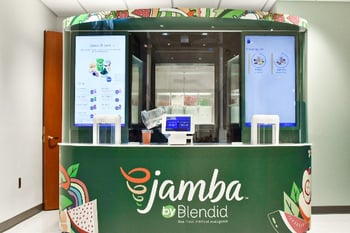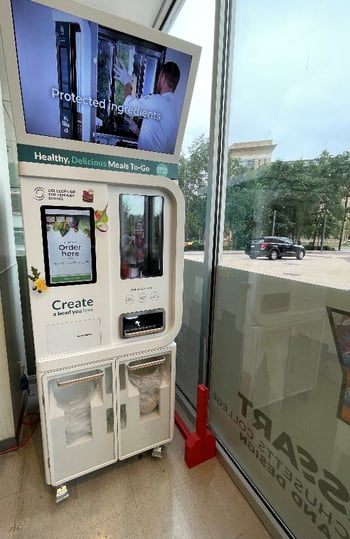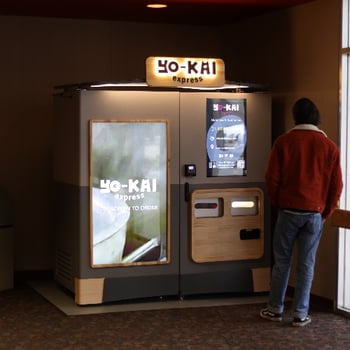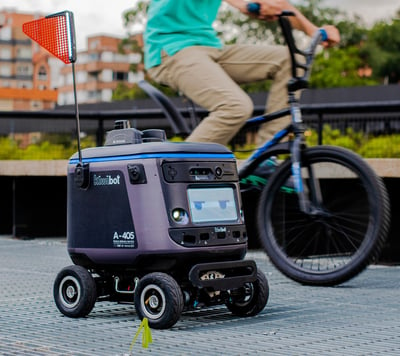Trend Watch: Robotic Technology Enhances Dining on Campus
Humans are uniquely capable of envisioning fantastical futures, marked by dazzling technology that has yet to be developed. From cars that soar high above the city and alleviate traffic jams to teleporters that allow us to travel miles in the blink of an eye, we dream of doing extraordinary things through technology. One futuristic technology has remained an enduring area of interest: robots. For nearly a century, robots have captured our imaginations, filling movie and television screens and frequently popping up in literature and even music. We’ve been fascinated by the idea of a future in which robots help with tasks and make our lives easier, more convenient, and more productive.
While we may still be many years away from flying cars and personal jetpacks, there has been ample innovation in robotic technology in recent years. The drive toward robotic automation accelerated during the COVID-19 pandemic, as consumers sought ways to avoid crowded spaces and minimize close contact. College campuses offer an ideal environment for progress in this field, as young consumers tend to be eager to try new technologies.
Sodexo has partnered with innovative industry leaders to bring convenient dining options supported by the latest in robotic technology to campuses across the country. These exciting new programs elevate the dining experience while making it safer and more convenient than ever. And with 56% of Gen Z stating they want fun retail experiences that keep them from getting bored, the novelty of these dining experiences enhances student engagement and satisfaction.
 A Fresh Twist on Smoothies
A Fresh Twist on Smoothies
In January, Sodexo debuted a Jamba by Blendid autonomous robotic smoothie kiosk at Georgia College. The kiosk offers a fun and convenient new way to enjoy freshly blended, made-to-order fruit and vegetable smoothies.
Guests can choose from seven delicious recipes and customize orders according to their dietary needs and preferences. After customers place and pay for orders via a touchscreen or on their smartphone, the autonomous kiosk measures and dispenses precise amounts of ingredients and then blends and pours each smoothie. The ordering and pick-up process is completely contactless. The Jamba by Blendid system can prepare and serve a smoothie in under three minutes. It can process up to 45 drinks an hour and nine drinks simultaneously.
This is the first Jamba by Blendid kiosk on a college campus. The high-tech machines are the product of a partnership between Jamba, a global leader in healthy on-the-go food and drinks, and Blendid, a pioneer in the food automation industry. The kiosks combine robotics, machine vision, and artificial intelligence to create healthy and delicious smoothies made with whole fruits and vegetables.
 Sally the Salad-Making Robot
Sally the Salad-Making Robot
Sally the Robot, powered by Chowbotics, assembles customized, on-demand bowls from fresh ingredients. Guests use a touch screen to choose a base of greens or grains and add-ins, including a rotation of seasonal vegetables and toppings such as seeds and dried fruit. Sally the Robot then assembles the salad right before the customer’s eyes.
Sally the Robot can effectively and safely handle nearly two dozen ingredients for endless varieties of salad. Integrated technology monitors the machine’s inventory to notify dining teams when items need to be restocked and ensure only the freshest ingredients are used.
Sally the Robot offers a unique experience and provides 24/7 access to fresh meals on campus at the Colleges of Fenway. Students there particularly enjoy this option during off-hours when other dining locations are closed.
 YoKai Express Noodle Machines
YoKai Express Noodle Machines
Yo-Kai Express is an autonomous restaurant that combines robotics, artificial intelligence, and culinary innovation to offer on-demand dining at any time of the day or night. At these cutting-edge vending kiosks, guests order and pay via a touchscreen with an intuitive user interface. The machine prepares fresh meals in under 60 seconds, using recipes created by Yo-Kai’s own Michelin-starred chef. The menu features authentic Asian cuisine, including Taiwanese beef noodle soup, Vietnamese pho, udon noodles, teriyaki rice bowls, Korean and Japanese ramen, and more.
Each Yo-Kai Express autonomous restaurant meets high food safety and sanitization standards and produces nearly zero food waste while giving students 24/7 access to freshly prepared meals. The machines are particularly useful late at night when options are limited but demand is high. In addition, Yo-Kai Express offers contactless dining, which has significantly grown in popularity in recent years.
Sodexo introduced the first Yo-Kai Express machine on a college campus in late 2021 at New Mexico State University and is working to bring the revolutionary technology to 10 additional campuses in 2022.
 Autonomous Delivery Robots
Autonomous Delivery Robots
Semi-autonomous delivery robots have caused quite a buzz since they began rolling onto college campuses, creating an immediate and enthusiastic following among students and faculty who enjoy the convenience and novelty the robots offer. Sodexo has partnered with two leading companies, KiwiBot and Starship Technologies, to develop this unique self-driving robot program, deploying a fleet of small robotic pods that deliver food all over campus. Originally launched at George Mason University, these robots have since expanded to nearly 20 campuses around the country, including Embry-Riddle Aeronautical University and Gonzaga University.
Students place orders via an app and specify a delivery location on campus. Dining employees prepare orders and load them into the robots’ locked compartments, which can carry about 22 pounds. An interactive map allows users to watch as the robot makes its journey to them. When the delivery arrives, students use a code in the app to open the compartment and access their food. The compartment is carefully sanitized between each use.
The zero-emission robots use a combination of sophisticated machine learning, artificial intelligence, and sensors to safely navigate campuses. They can cross streets, climb curbs, travel at night, and operate in both rain and snow.
Students and faculty enjoy seeing the adorable robots gliding around campus, bringing smiles as they pass and making it easy to enjoy convenient contactless dining.